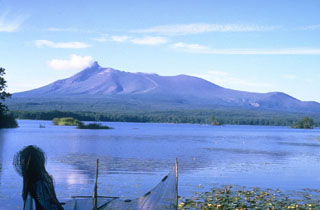Report on Hokkaido-Komagatake (Japan) — May 1990
Bulletin of the Global Volcanism Network, vol. 15, no. 5 (May 1990)
Managing Editor: Lindsay McClelland.
Hokkaido-Komagatake (Japan) Weak vapor emission; earthquake swarm
Please cite this report as:
Global Volcanism Program, 1990. Report on Hokkaido-Komagatake (Japan) (McClelland, L., ed.). Bulletin of the Global Volcanism Network, 15:5. Smithsonian Institution. https://doi.org/10.5479/si.GVP.BGVN199005-285020
Hokkaido-Komagatake
Japan
42.063°N, 140.677°E; summit elev. 1131 m
All times are local (unless otherwise noted)
Seismicity has generally remained low since 1966 when JMA installed a sensitive seismometer (2,000x magnification) 4.1 km WSW of the summit crater. This low level was punctuated during recent years by several swarms of small earthquakes. On 13 June 1983, 19 earthquakes were recorded from 1842 until 1900. At 1416 on 3 December 1989, a shock (M 3.4) felt at the base of the volcano was located 7 km N of the summit at 4 km depth by the seismic network. Twenty small earthquakes were recorded in the next 4 hours and roughly 50 from 0034 to 0144 on 7 April 1990. The wave form and character of the 7 April swarm was very similar to that of the 1983 swarm, but different from that of December 1989. Despite the increased seismicity, steady weak steam emission from the fumarolic area on the summit continued unchanged as of early June.
Geological Summary. Much of the truncated Hokkaido-Komagatake andesitic volcano on the Oshima Peninsula of southern Hokkaido is Pleistocene in age. The sharp-topped summit lies at the western side of a large breached crater that formed as a result of edifice collapse in 1640 CE. Hummocky debris avalanche material occurs at the base of the volcano on three sides. Two late-Pleistocene and two Holocene Plinian eruptions occurred prior to the first historical eruption in 1640, which began a period of more frequent explosive activity. The 1640 eruption, one of the largest in Japan during historical time, deposited ash as far away as central Honshu and produced a debris avalanche that reached the sea. The resulting tsunami caused 700 fatalities. Three Plinian eruptions have occurred since 1640; in 1694, 1856, and 1929.
Information Contacts: JMA.

